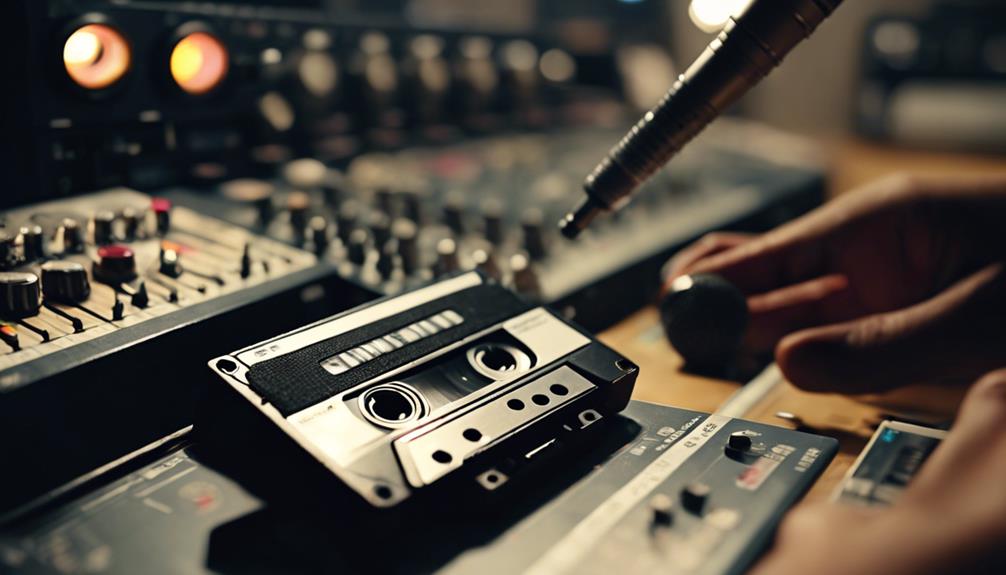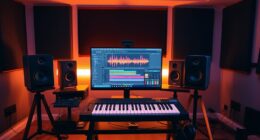Hey there, tape enthusiasts! Ready to rock those cassette tapes? First, select the right tape – Chrome's the excellent choice! Gather equipment like a player and cables. Set up in a cool, quiet space ergonomically. Dial in those bias settings for high-quality sound. Embrace Dolby for hiss-free tunes. Watch those input levels – no screechy sound, please! Test levels with care to avoid distortion. Hit record, monitor, and play! Check playback quality using headphones. Finalize your masterpiece, label it, and store with care. Want more tips? Keep grooving for the ultimate tape recording guide!
Key Takeaways
- Select the right cassette tape type based on sound preference and budget.
- Gather necessary equipment like a recorder/player, blank tape, and cables.
- Set up a recording space with good lighting, ventilation, and cable management.
- Understand tape bias settings for optimal sound quality and fidelity.
- Implement noise reduction techniques like Dolby to minimize background hiss.
Selecting the Right Cassette Tape
When selecting a cassette tape for recording songs, it's important to examine the various types available to ensure excellent sound quality and performance.
Among the different options out there, we've Type IV and Chrome tapes that stand out from the crowd. Chrome tapes, with their extra notches, strike a sweet spot between Type I and Type II tapes, offering a balanced sound quality that's sure to impress your ears. Perfect for those looking for a blend of affordability and performance.
On the other hand, Type IV metal tapes are the cream of the crop when it comes to sound quality. If you're a professional recording artist or an avid audiophile, these tapes will take your music to a whole new level of clarity and richness.
Gathering Necessary Equipment

Alright, let's delve into the exciting world of gathering the gear we need to start recording songs on our trusty cassette tapes!
First up, we'll need a cassette recorder/player with that nifty line-in input feature.
Don't forget to grab a blank cassette tape and a 3.5mm stereo to RCA cable for connecting your devices.
It's like putting together a musical puzzle, and we're just getting started!
Equipment Needed
To start recording songs on cassette tapes, gathering the necessary equipment such as a cassette tape deck, a hi-fi receiver with speakers, and RCA audio cables is essential.
Picture it: your favorite tunes captured on a trusty cassette tape, ready to blast through those vintage speakers like it's the '80s all over again.
The cassette tape deck is your knight in shining armor, the hi-fi receiver with speakers its loyal steed, and the RCA audio cables the magical ropes that connect it all together.
With this trio by your side, you'll be prepared to set off on a musical journey filled with rewinds, fast-forwards, and maybe even a bit of accidental tape tangling (it happens to the best of us).
Let's get this retro party started!
Recording Environment
In setting up the recording environment for recording songs on cassette tapes, the essential equipment, such as a tape deck, hi-fi receiver, RCA audio cables, and speakers, must be gathered. To guarantee high-quality sound when recording on cassette, a stable power setup with a strip cord is important. Make those connections pop by checking the hi-fi receiver for designated out jacks for tape deck recording. Connect the playback and input ports like a pro. Test your setup with external devices, like a CD player, to confirm all connections are on point before hitting that record cassette button. Don't forget about tape bias settings and Dolby noise reduction options to minimize background hiss and maximize your jam session's quality.
| Equipment | Description | Importance |
|---|---|---|
| Tape Deck | Records audio onto tapes | Essential |
| Hi-Fi Receiver | Amplifies and routes audio | Crucial |
| RCA Audio Cables | Connects devices | Necessary |
| Speakers | Output sound | Indispensable |
| Strip Cord | Provides stable power | Important |
Setting Up Your Recording Space
Alright folks, let's get this recording space party started!
Choosing the right spot is key – think quiet, well-lit, and roomy to fit all your gear.
Make sure you set things up ergonomically for easy access, and hey, don't forget about good ventilation to keep those devices cool.
Let's create a space that's not just functional but cozy too!
Choose Suitable Location
Selecting a quiet and well-insulated room for recording on cassette tapes minimizes external noise interference, ensuring excellent sound quality. Think of this space as your creative cocoon, where you're the audio artist painting with soundwaves. To help you envision your ideal recording nook, here's a nifty table for your inspiration:
| Recording Space Essentials | Importance |
|---|---|
| Lighting and Ventilation | Stay comfy! |
| Equipment Placement | Easy access! |
| Ergonomic Setup | Comfort first! |
| Acoustic Treatment | Clear sound! |
Arrange Necessary Equipment
Now that you've identified the ideal location for your recording space, let's focus on setting up the necessary equipment for your cassette tape recording session.
To start off on the right note, make sure your tape deck, receiver, and speakers are all snug on sturdy surfaces to keep vibrations at bay.
Next up, wrangle those cables! Proper cable management is key to avoid a spaghetti junction and pesky interference during your recording sesh.
When positioning your gear, think convenience – you want easy access to controls and levels to keep the music flowing smoothly.
And hey, if the room needs a little acoustic love, consider some soundproofing to really make those tunes pop.
Let's get this setup party started!
Understanding Tape Bias Settings
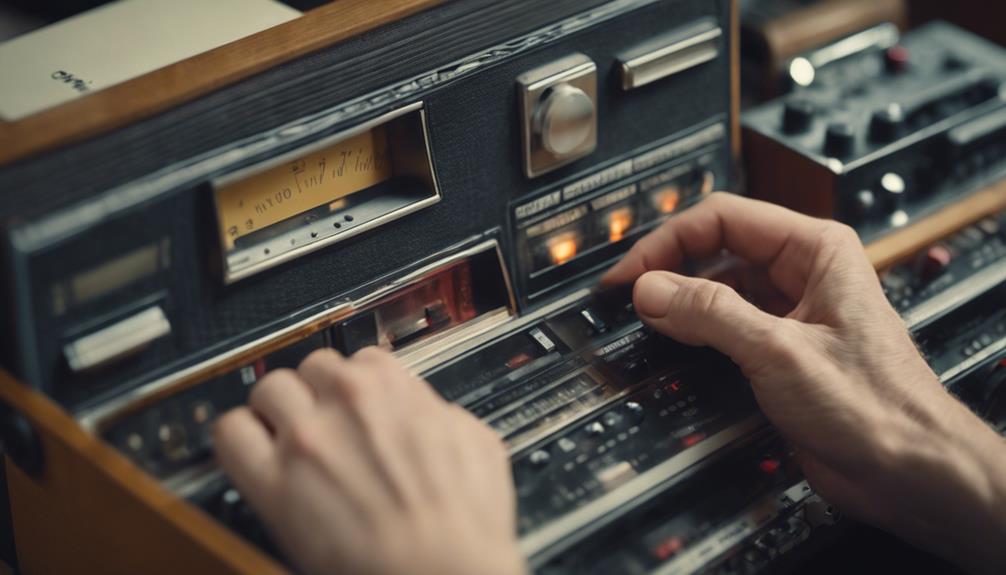
Adjusting tape bias settings on cassette tapes is essential for maximizing the sound quality of recordings by manipulating the magnetic bias during the recording process. Different types of cassette tapes, such as Type I, Type II, and Type IV, require specific bias adjustments for peak performance. While Type I tapes usually don't need bias adjustments, Type II and Type IV tapes may benefit from high bias settings to achieve the best results. Proper bias adjustment plays a significant role in reducing distortion and enhancing the overall fidelity of the recorded music on cassette tapes. Consult your tape deck manual for guidance on adjusting bias settings according to the type of cassette tape you're using.
Here's a nifty table to help you understand the basics of tape bias settings for different types of cassette tapes:
| Cassette Tape Type | Bias Adjustment Required | Best Bias Setting |
|---|---|---|
| Type I | Rarely | N/A |
| Type II | Sometimes | High |
| Type IV | Often | High |
Implementing Noise Reduction Techniques
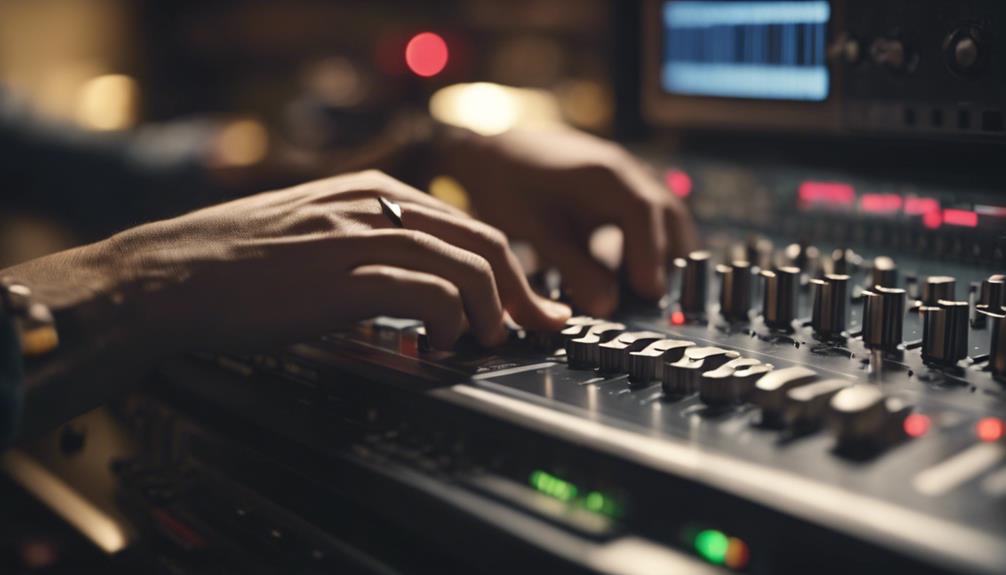
When enhancing the quality of cassette tape recordings, addressing noise reduction techniques is essential. Dolby Noise Reduction, a magical tool in the world of audio, works wonders in minimizing that pesky background hiss that loves to sneak its way into our cherished recordings. With different Dolby types like B, C, and S offering varying levels of noise reduction, it's like having a superhero squad ready to fight off any unwanted audio intruders.
Choosing the right Dolby setting based on your cassette tape type is vital for achieving excellent recording quality. Dolby Noise Reduction operates by encoding the audio during recording and then decoding it during playback, almost like decoding a secret message, but way cooler. Understanding how Dolby Noise Reduction plays along with tape bias settings is the secret sauce to maximizing the full potential of your sound quality.
Adjusting Recording Levels
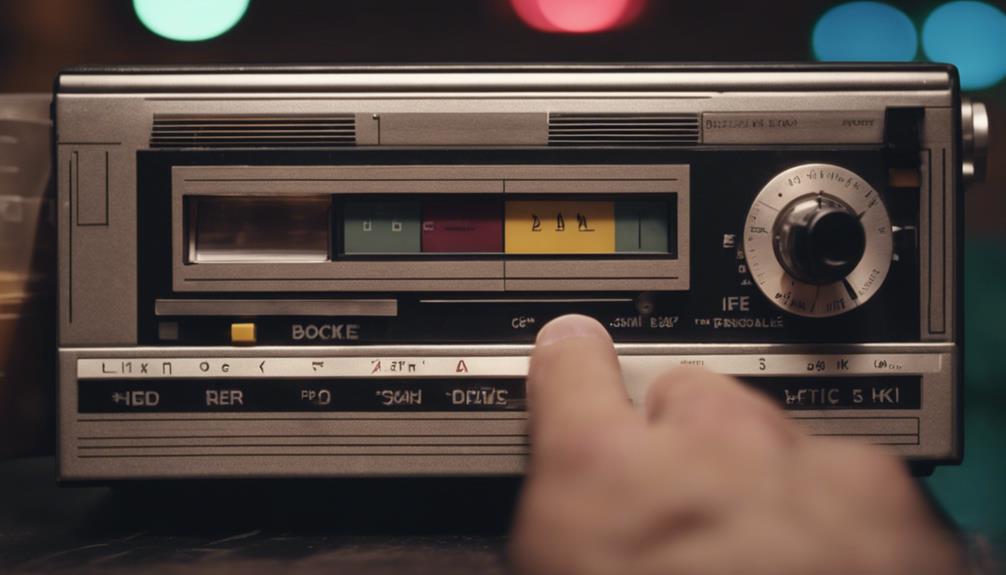
Alright, folks, let's talk about adjusting those recording levels! It's essential to get the input levels just right to avoid any pesky distortion that can ruin your jam session.
Keep an eye on those VU meters, tweak the settings, and make sure you're not maxing out the capacity – we want our tunes to sound clear and crisp, not fuzzy and overblown!
Setting Proper Input Levels
To achieve excellent sound quality and avoid distortion in your recordings, it's important to carefully adjust the input levels during the recording process. Think of input levels as the volume knob for your cassette tape recording; set it too high, and your music might sound like a cat choir on a bad day – yowling and screechy. Too low, and you'll strain to hear a whisper in a hurricane. Keep an eye (and ear) on those levels using fancy tools like VU meters or digital indicators.
It's like discovering that sweet spot on a see-saw – not too high, not too low, just right. Experimenting with different levels is the key to revealing the golden gate of audio balance.
Avoiding Clipping Distortion
How can we guarantee our cassette tape recordings are free from clipping distortion and maintain peak audio quality? When it comes to recording levels, finding that sweet spot is key. We want our music to sound crisp, not like a robot having a meltdown. To help you visualize this, let's break it down in a cool table:
| Recording Levels | Outcome |
|---|---|
| Too Low | Muffled sound, no bueno |
| Just Right | Crystal clear tunes, yay! |
| Too High | Clipping distortion, oh no! |
Testing Levels Before Recording
To guarantee excellent audio quality and avoid clipping distortion when recording songs on cassette tapes, it's essential to painstakingly test and adjust recording levels beforehand by monitoring the VU meters on the tape deck. These meters are like the guardians of your sound, ensuring it stays within the optimal range of clarity and balance.
Using test tones or music with varying intensity, we can dial in the perfect levels that will make your recordings sing like a happy cassette tape choir. Remember, too high, and you risk that dreaded distortion, too low, and your sound might as well be whispering in a hurricane.
Properly calibrated levels are the secret sauce to getting those crystal-clear recordings that will have your cassette tape grooving like never before.
Initiating the Recording Process
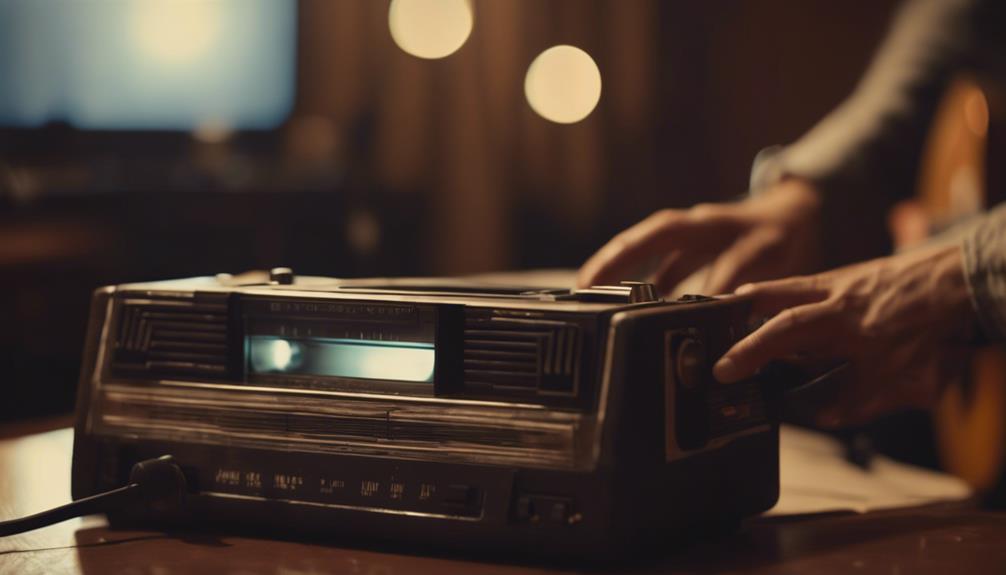
Selecting the desired side of the cassette tape is essential to ensure that the recording process starts smoothly and efficiently. It's like choosing the perfect flavor of ice cream before indulging in a delightful sundae! Once we've picked side A or side B, we need to make sure our tape deck is in record mode, eagerly anticipating to capture our musical masterpiece. Think of it as your reliable companion, ready to assist you in conquering the music world.
Moving on, let's discuss input levels. We wouldn't want our tunes to sound like a robot underwater, right? Checking the input levels on the tape deck is vital to avoid any unwanted distortion or clipping during recording. It's like adjusting the volume on your car stereo so your favorite song sounds just perfect.
Now that everything is prepared, press play on your music source and let the magic begin! Witness as the songs transfer onto the cassette tape, creating a mixtape that will impress all your friends. Keep a close eye (or ear) on the recording progress to ensure that every beat and lyric is captured flawlessly. And there you have it – the start of your musical journey on a classic cassette tape. Let the recording adventures begin!
Monitoring Playback Quality
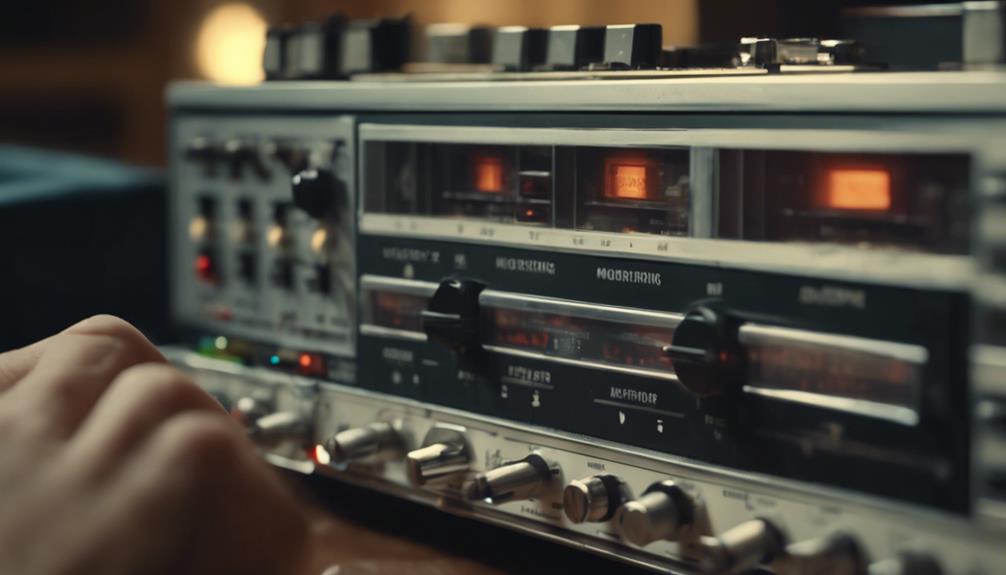
Imagine this: you've just laid down some sick beats on your cassette tape, but what good are they if they sound like they're coming from a tin can connected to a potato? That's where monitoring playback quality steps in!
Grab your trusty headphones, slap them on, and hit play. Listen carefully for any signs of trouble – like distortion making your favorite guitar riff sound like a dying robot, muffled vocals that turn your lyrics into a secret code only dolphins can decipher, or imbalanced audio levels that make your bass line disappear faster than a cookie jar at a kid's party.
Adjust that playback volume, keep an ear out for unwanted background noise or tape hiss trying to steal the show, and make sure your masterpiece shines through crystal clear. Remember, monitoring is key to catching any gremlins messing with your tunes and ensuring your listeners get the full cassette tape experience they deserve!
Finalizing the Recording

Let's make sure the recording on the cassette tape is finalized smoothly by confirming the absence of any distortions or background noise that could impact the quality. No one wants a masterpiece ruined by a sudden burst of static or the neighbor's lawnmower making a surprise guest appearance on your mixtape. So, rewind that trusty cassette tape to the beginning of your latest jam. Get ready for the moment of truth – the playback. Press play and listen closely. Does it sound as excellent as butter, or are there gremlins messing with your tunes? Keep those ears sharp!
Once you've given it a good listen and ensured the recording quality is superb, don't forget the final touch – labeling. Give your cassette tape some identity. It's not just any tape; it's your creation. Write down the song title, artist name, and any other important details. This way, when you're searching for that perfect track to impress your friends, you'll know exactly which tape to grab. Recording, checking, labeling – you're on a roll!
Storing and Maintaining Cassette Tapes
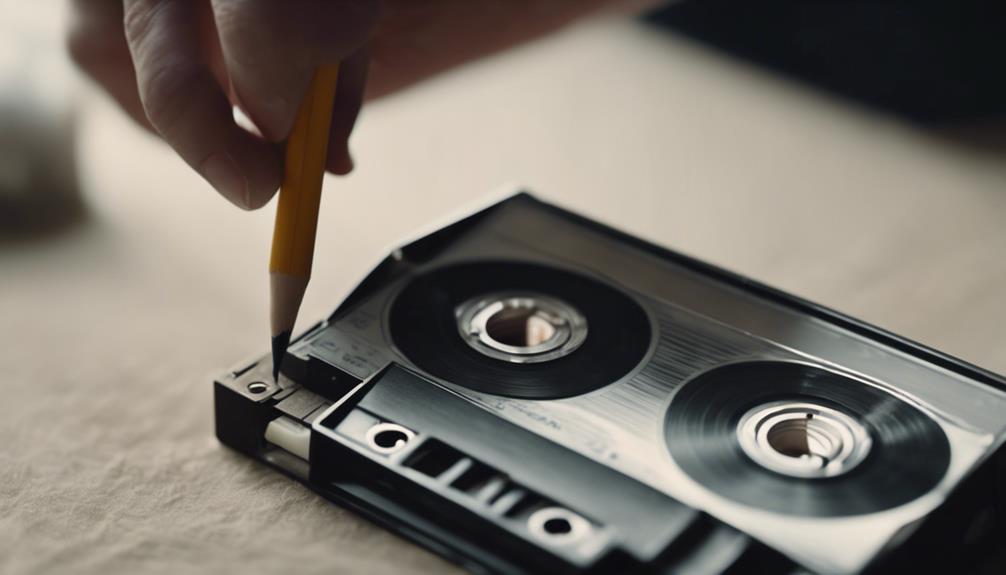
Discussing the correct storage and maintenance of cassette tapes guarantees their longevity and best playback quality. When it comes to keeping your tapes in top shape, here are a few tips to help you out:
- Store upright: Just like books on a shelf, keeping your cassettes standing upright can prevent warping and keep the tape from getting distorted.
- Avoid extreme conditions: These tapes are like delicate flowers; they don't like extreme temperatures or humidity. So, don't leave them in the sweltering heat or freezing cold!
- Stay away from magnets and sunlight: Your tapes aren't big fans of magnets or direct sunlight. It messes with their groove, literally.
- Use protection: No, not that kind! Get some plastic storage cases to shield your tapes from dust and any physical harm that might come their way.
Frequently Asked Questions
How Do You Record Songs Onto a Cassette Tape?
We record songs onto a cassette tape by selecting the right blank tape type for our preferences.
We set up the tape deck and receiver with RCA cables for high-quality recording.
Adjust tape bias settings based on the tape type for the best sound quality.
Select the Dolby Noise Reduction setting to reduce background hiss.
Keep an eye on sound levels, adjusting volume for a balanced audio output.
How Was Music Recorded on Cassette Tapes?
Well, back in the day, music was recorded on cassette tapes by connecting a hi-fi receiver and a tape deck. Ensuring the best sound quality meant adjusting tape bias settings and using Dolby noise reduction.
Different cassette tape types like Type I, II, III, and IV each had unique sound characteristics. Those notches on the tapes helped us pick the right one – Type IV metal tapes were the top dogs for sound quality!
How Do You Record Audio on a Tape?
When recording audio on a tape, we start by connecting the playback ports of a tape deck to the input ports of a receiver using RCA cables. Adjusting tape bias settings according to the cassette type guarantees excellent sound quality.
Choosing the right Dolby Noise Reduction setting, like B, C, or S, helps minimize tape hiss.
Making sure all devices and speakers are properly connected is vital for a smooth recording experience. Monitoring sound levels and adjusting volume as needed ensures a balanced and clear audio recording on cassette tapes.
How Do I Capture Audio From a Cassette Tape?
Well, capturing audio from a cassette tape is like setting off on a musical treasure hunt!
We connect a cassette deck with a line-out feature to a recording device or computer. Adjust recording levels to prevent distortion and guarantee crystal-clear audio.
It's like being a sound detective, enhancing the captured audio with editing software for that perfect mixtape vibe.
Save it digitally for easy playback and relive those retro tunes!
Conclusion
With these 10 steps, you'll be well on your way to recording your own songs on cassette tapes like a pro.
Just remember, the possibilities are endless when it comes to creating music on these little magnetic wonders.
So grab your tapes, get your gear ready, and let the music flow like a river of groovy goodness.
Happy recording!
